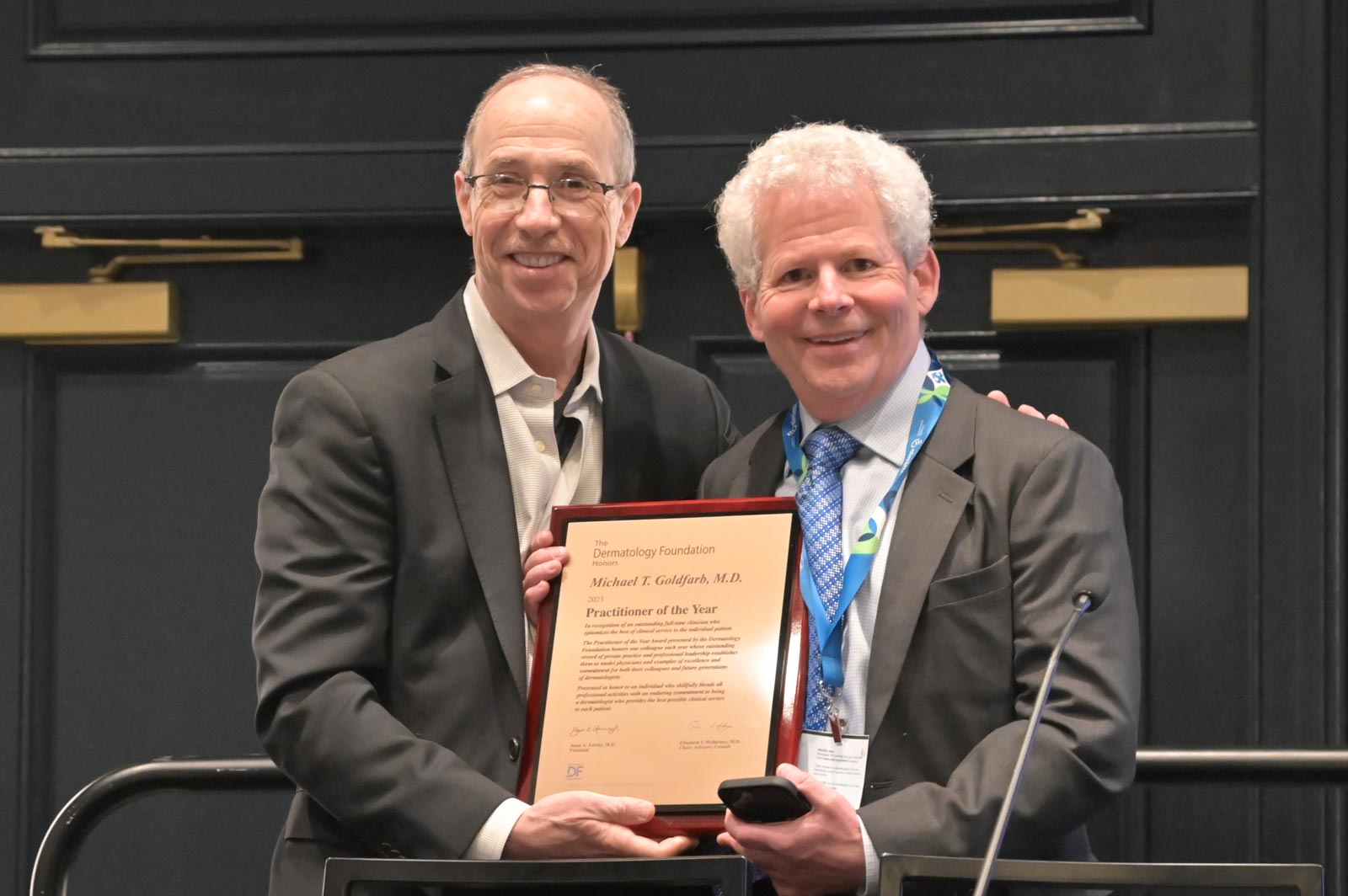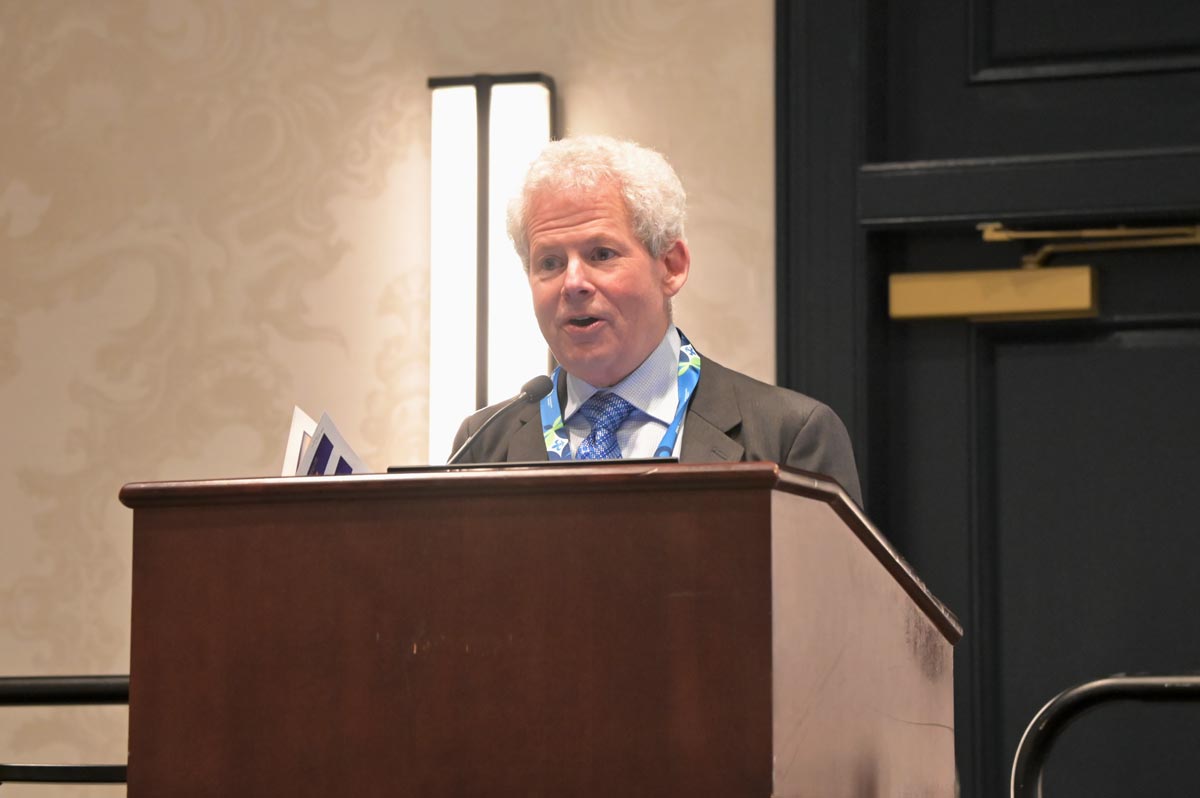The Value of Connection
Michael D. Goldfarb, MD, DF 2023 Practitioner of the Year
August 2023

Dermatology Foundation President Dr. Janet Fairley called Michael T. Goldfarb, MD, to share he had received the 2023 Practitioner of the Year Award. Her ties to Dr. Goldfarb stretch back to medical school when she was a third-year resident, and he was in his fourth year of medical school at the University of Michigan. She was Dr. Goldfarb’s first mentor.
Jonathan Weiss, MD, who first became friends with Dr. Goldfarb 40 years ago, presented his award at the 2023 DF annual meeting. Dr. Weiss was a resident when Dr. Goldfarb was a new attending and they worked together in clinical and research settings at the University of Michigan dermatology department. “Jonathan and I lectured around the country on tretinoin, the hot topic in the 1980s. I’ve known Janet and Jonathan since very early in my career and it was such an honor to receive this award from them.”

Michael T. Goldfarb, MD, the DF 2023 Practitioner of the Year.
The DF Practitioner of the Year Award honors one colleague each year whose outstanding record of private practice and professional leadership establishes them as model physicians and examples of excellence and commitment for their colleagues and future generations of dermatologists.
The award honors an individual who skillfully blends all professional activities with an enduring commitment to being a dermatologist and who provides the best possible clinical service to each patient.
A perfect situation
Dr. Goldfarb went to medical school at the University of Michigan and interned at Cedar Sinai in Los Angeles, where he planned to do his dermatology residency at UCLA. But he missed Michigan and its “northern climate,” so he returned to Michigan.
He had just completed his residency in 1985 when a dermatologist with a private practice approached the University and asked if they would like to buy it. So they did; running a remote satellite appealed to the dermatology department at the time. It was a busy practice, but the business model clashed with the university system; they decided to sell the practice.
Dr. Goldfarb was invested in the practice and his work there, so he bought it.
However, he was allowed to continue as faculty at the University of Michigan with a part-time appointment. Therefore, he could work with residents and participate in clinical research at a time when biologics were being developed for dermatologic treatment. He trained residents in clinical research and saw patients in a clinical setting in his private practice — two environments that presented specific challenges to succeed.
Dr. Goldfarb is an adjunct clinical instructor in the dermatology department at the University of Michigan Medical School (since 1985) and an attending physician in the department of medicine at Beaumont Hospital (since 1987).
His students are primarily interns, eight from Beaumont and five residents from the University, as well as one clinical research fellow. “I usually have one student in my practice every day.”
Frequently, Dr. Goldfarb works with a resident doing clinical research at the University. He imparts knowledge, certainly, but he also teaches how to write case reports and patient evaluations that are easy to understand, critical skills he learned from mentors during his residency.
He also lectures in internal medicine, general dermatology, and family practice twice yearly. “I keep them up to date on the latest medications, current treatments for acne and psoriasis,” he said. But most of his teaching is either bedside or in the clinic.
He also was an active participant in professional societies: American Medical Association (1977), American Academy of Dermatology (1986), Michigan State Medical Society (1986), Wayne County, Michigan Medical Society (1986), and Michigan Dermatologic Society (1986), where he held elected positions as president (1996), president-elect (1995) and secretary/treasurer (1993-1994).
An environment of care
In the 38 years he has mentored residents, lectured on dermatology, and run a clinical practice, Dr. Goldfarb has advocated the value of human connection with patients and residents. He believes it inspires trust, enables learning, creates a reciprocal environment of care, and is the central element to bring to a lecture hall, a clinical research unit, or a patient clinic.
“To relate and care about them [residents and patients] as people, to share, not just your interest in them, your life as well, to the degree you’re comfortable with,” he said.
Research improves options
The “humanity of the specialty,” as he calls it, was one reason he became a dermatologist. The diagnosis-treatment-solution equation was the other. “The speed with which we can diagnose and get the patients well is rewarding. However, prior to the biologic therapies, seeing psoriasis and atopic dermatitis patients returning to his clinic was less so because the treatment did not work as well as he and the patients had hoped.
It was a much-discussed topic at the National Psoriasis Foundation, where Dr. Goldfarb was a member. He describes an “aha” moment during a meeting about 25 years ago before biologics treatments were available.
“One of the speakers said, ‘We have done nothing for psoriasis.’ Well-known psoriasis specialists filled the room, and they were up in arms, saying, ‘We’ve done so much,’ and he replied, not that much more than what we did 100 years ago or 60 years ago.’
“And I knew what he meant: we weren’t giving these people their lives back.”
That changed with the advent of biologics treatments. “The skin cleared for many patients, and many don’t feel like they have psoriasis anymore,” Dr. Goldfarb said.
While there is no cure for psoriasis, ongoing research increases the number of treatment options. It helps patients and their dermatologists manage the disease.
“I had a patient with a malignant melanoma on his lower back, which had metastasized. He had a high mortality rate. I was able to include him in an immunotherapy trial at the University of Michigan. The therapy caused a severe case of colitis and his weight to drop from 180 pounds to 110. Yet over time, the therapy worked, and his tumors melted away.
“Today, he is cured. He was 71 at the time; he’s now 91. He still has a full life. I could never have imagined that.”
Paying it forward
As a member of the Leaders Society and the Annenberg Circle, Dr. Goldfarb is unwavering about the Foundation’s role in his career.
Many people he has worked with got their career start through the Foundation’s Research Award Program. And he has done much of his clinical research with people whose careers began with DF support, Johann E. Gudjonsson, MD, PhD, and Sewon Kang, MD, for example.
“They were essential to my career,” he said. “Had they not gotten that research support to get their careers going, I too would not have had the opportunity to do my clinical research with them.”
A matter of respect
Dr. Goldfarb started his practice in 1985, and many of his first patients are still with him today, 38 years later.
“I want them to think of me as someone they can count on and who cares about them as a whole person.”
When patients offer thank-you gifts, he writes thank-you notes. “I appreciate them and want to acknowledge what a nice thing they did for me.”
BIOGRAPHY
Dr. Michael T. Goldfarb has been a faculty member at the University of Michigan’s Department of Dermatology since 1985. He graduated from the University of Michigan Medical School in 1981, completed an internal medicine internship at Cedars-Sinai in 1982, and completed his residency in Dermatology in 1985 at the University of Michigan.
Dr. Goldfarb has participated in numerous clinical studies at the University of Michigan, exploring new therapies for treating acne, warts, fungal disease, aging skin, psoriasis, atopic dermatitis and a variety of other dermatological conditions. He maintains a general dermatology practice in Dearborn, Michigan.
Dr. Goldfarb is affiliated with two hospitals in the area, including University of Michigan Health-Ann Arbor and Beaumont Hospital-Dearborn.
He has been president of the Michigan Dermatological Society and is author or co-author of some 30 scholarly papers and ten book chapters; he has edited one book.
PUBLICATIONS
A systematic review of the safety of topical therapies for atopic dermatitis
J.P. Callen, Sarah L. Chamlin, Lawrence F. Eichenfield, Charles N. Ellis, Michael Girardi, Michael T. Goldfarb, Jon M. Hanifin, P. Lee, David J. Margolis, Amy S. Palle…; British Journal of Dermatology. 2007 Feb 1
Evaluation of safety and clinical activity of multiple doses of the anti-CD80 monoclonal antibody, galiximab, in patients with moderate to severe plaque psoriasis
Alice B. Gottlieb, Sewon Kang, Kenneth G. Linden, Mark Lebwohl, Alan Menter, Ahsan A. Abdulghani, Michael T. Goldfarb, Nicole Chieffo, Mark C. Totoritis; Clinical Immunology. 2004 Apr 1

